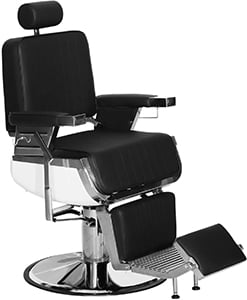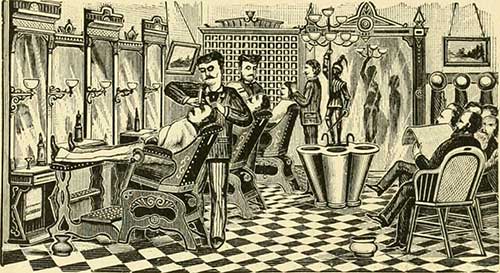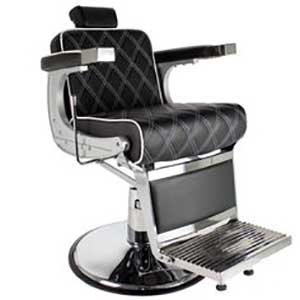If you own a business that offers haircuts or shaves, barber chairs are going to be a necessary addition. The different types of barber chairs out there serve a wide variety of needs and purposes. Whether you want something fancy, simple, or antique, there are plenty of options.
In this article, we’ll look at all the different options you have for barber chairs, followed by an examination of the history behind them.
The Different Types of Barber Chairs
There are several categories of barber chairs, along with several types. Here we will cover all the options. Today’s chair options include a lot of features, but there are also more simplistic designs for those who don’t need all the bells and whistles.
All-Purpose Chairs
All-purpose barber chairs are great for shops that offer haircuts and shaves. They can also be useful for tattoo artists or even dentists. Since these chairs offer height adjustments and comfortable seating, they are a perfect fit.

With multiple features included, these chairs can also fit perfectly in most settings and adapt to your needs.
Traditional Barber Chairs
Traditional barber chairs are standard choices that have hydraulic lifts the barber can use. They have footrests and headrests as well. They are commonly upholstered in synthetic leather or vinyl for customer comfort.

Antique Barber Chairs
Older antique barber chairs can be expensive, but they offer an elegant and compelling design for barber shops. They are commonly crafted from wood and leather instead of synthetic options that most other chairs use.

These chairs come from a time when mass production wasn’t as important as quality, so they are very intricate and well-designed.
European Chairs
Barber chairs from Europe tend to have heavy wooden arms, but otherwise still include headrests and detachable footrests. As with any other type of barber chair, these come in various types of materials and designs.

Now, we’ll take a look at the different types of features you may see integrated into barber chairs.
4 Types of Barber Chair Mechanisms
Barbers need to move a client around and adjust their height to give them the best haircut or shave. As a result, barber chairs often have different types of mechanisms that allow for more customization in the experience.
Here the four types you will see in your search:
Electric
Electric barber chairs offer a lot of control. The headrest, for example, can be adjusted up to 7” or more. The mechanism here also allows for adjustment of vertical motion and the reclining mechanism.

Individual aspects of the chair can also be adjusted independently. The leg rest, for example, can be moved while keeping the footrest stationary. It can also adjust to different heights and customers who are younger or older.
Reclining
Reclining chairs can be great for barbers, especially when shaving a customer. Many of them have locking mechanisms that prevent spinning or unwanted movement. The other parts of the chair can be adjusted as well, offering various angles and precision.

Swivel
These types of chairs are commonly made with a sturdy steel frame and cushions for comfort. You’ll find that these can be made of aluminum, stainless steel, and chrome. They include a footrest as well.

Hydraulic Barber Chairs
Not only do hydraulic chairs make the barber’s job easier, but they make it safer as well. The height adjustment is precise and easy to adjust, regardless of the total weight. It can help barbers place customers in a perfect position for a haircut or shave.

The History of Barber Chairs
Barber chairs date back to the American Civil War. The first chairs manufactured in factories date back to around 1850. Original barbers chairs with a footrest were patented in 1878 by the Archer Company in Saint Louis.

The company followed this with a second chair model that moved up and down using a mechanism. A man from Cincinnati by the name of Eugene Berninghaus improved upon the design and created the Paragon. This chair was unique because of its ability to both recline and revolve.
Theodore Koch from Chicago Incorporated took all of these improvements and added them into his chairs. He was able to sell over 35,000 chairs in the time before 1885.

The next big barber chair came from Samuel Kline who was in charge of the Kline Chair Company. His patent was challenged by Koch, but the lawsuit was ultimately overturned.
Kline’s patent was granted in 1907. Meanwhile, in Germany, a man by the name of Ernest Koken developed a hydraulic chair and patented his joystick side lever.
This level was used by the barber to control all of the mechanical functions of the chair. During the later part of the 1950’s, U.S. companies sold over 10,000 chairs each year to over 100,000 barber shops.
While the older style of barber shops only had one chair for a more personalized experience, modern barbers have many chairs and multiple stylists to serve more customers at a time.
Barber Chairs for Every Kind of Cut
The best types of barber chairs are the ones that offer a combination of comfort and precision for the barber. There are plenty of choices when it comes to style and mechanisms.
While the standard swivel chairs may be a good fit, the hydraulic options offer the ability to adjust height quickly and easily. It’s all up to the barber to decide which type is best for their needs.
Hello,I read your article on Barber Chairs how interesting. But I cannot understand why the Melchior Brothers are not mentioned.I have been researching Melchior Bro for some time,and they were very well respected of Barber Equipment.I ask because I have a 186? Melchior 3 round that I’ve spent weeks tracking this Chair.It has features that has lead me to believe this Chair was used at a “Knight of Pythias Lodge” that Hugo Melchior was a board member in Omaha.1st it has a Copper full Base,and carved Lion heads on the hand rest.If you look at KOP hand guard tip of the sword you will see a Lion Head.If any insight would greatly be appreciated. Al
Hi Al, and thank you for your comment! This piece in particular was meant as more of a general overview of barber chairs, but you raise a good point. A piece that focuses specifically on Melchior chairs and the history behind them would be an excellent addition to the site!
In answer to your question, we were unable to find any current Knights of Pythias lodges in Omaha, but there are three in the general vicinity:
Big Grove Lodge #226, In Oakland IA
College View Lodge #10 in Lincoln, NE
And a bit farther away, Ingomar Lodge #142, in Crete, NE
You can get more information here: https://knightsofpythias.squarespace.com/
It’s entirely possible that Mr. Melchior presided over one of those lodges in the vicinity of Omaha.
During our research, we also turned up a Facebook group called “Forgotten Omaha” which had an interesting post about Hugo Melchior. If you have a Facebook account, it’s well worth checking out. Not only does it have information you might find of value, it’s also got some great photographs and one of the discussion participants posted a family photo of Hugo, saying that “his wife’s brother’s granddaughter married her uncle.”
You can find the article and the discussion surrounding it here:
https://www.facebook.com/groups/ForgottenOmaha/permalink/1421871154540945/
And if you’re willing to share, we’d love to see pictures of your chair!